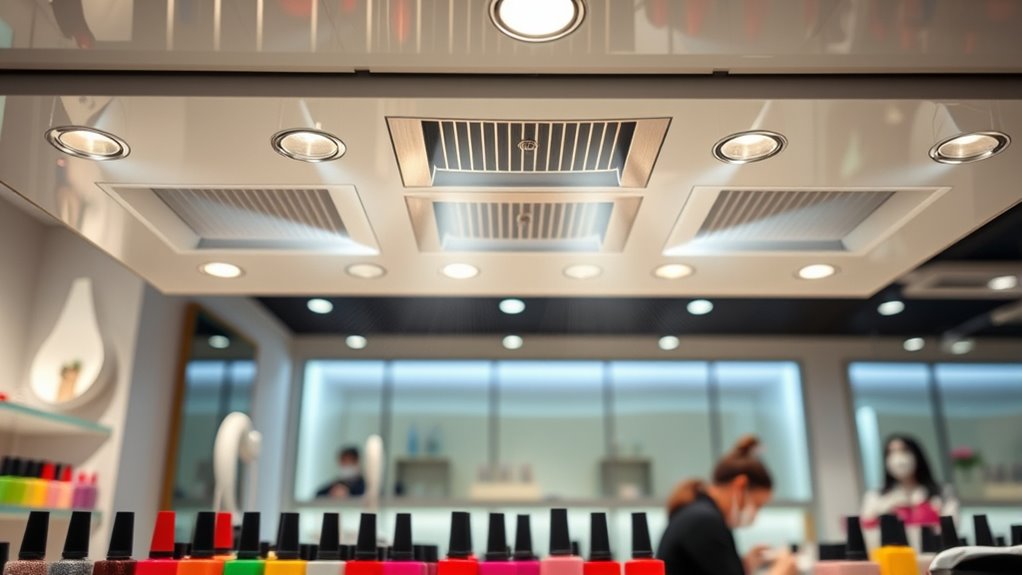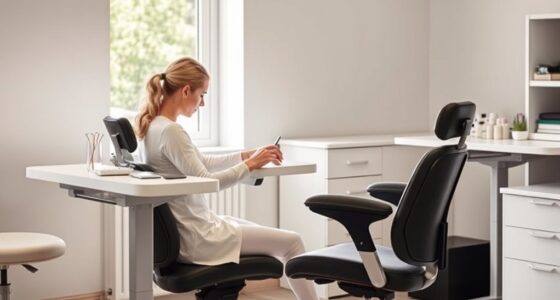Proper salon ventilation is key to protecting your lungs from nail fumes. Use mechanical systems like exhaust fans and high-efficiency filters, such as HEPA, near workstations with strong fumes. Incorporate natural airflow by opening windows and combine both methods for best results. Regularly maintain filters and monitor air quality to guarantee pollutants don’t build up. To create a safer, healthier space, learn more about effective ventilation strategies and how they safeguard your well-being.
Key Takeaways
- Use mechanical exhaust fans and air purifiers with HEPA filters near nail stations to remove fumes effectively.
- Incorporate natural ventilation by opening windows and doors during and after treatments to dilute airborne chemicals.
- Regularly maintain and replace filters to ensure continuous, optimal air filtration and prevent fume buildup.
- Monitor indoor air quality with air quality monitors and upgrade systems if fumes persist or air quality declines.
- Combine natural and mechanical ventilation strategies to create a comprehensive airflow system that protects lungs and health.

Proper ventilation is essential for creating a safe and comfortable salon environment. When you’re working with nail products, fumes and airborne particles can quickly compromise the air quality in your space. Poor air quality doesn’t just make the environment unpleasant; it can also pose serious health risks over time. That’s why investing in effective ventilation systems is crucial. These systems help remove harmful fumes, dust, and vapors, ensuring that your salon remains a healthy place to work and visit. Good ventilation isn’t just about comfort—it’s about protecting your lungs and overall well-being.
When selecting ventilation systems for your salon, focus on solutions that improve airflow and filtration. Mechanical ventilation, such as exhaust fans and air purifiers, actively draw contaminated air out of the space. These systems should be strategically placed near workstations where nail fumes are most concentrated. This targeted approach helps prevent fumes from lingering and spreading throughout the salon. Additionally, consider systems with high-efficiency filters that can trap tiny particles and chemical vapors, substantially enhancing the air quality. HEPA filters are particularly effective at capturing airborne contaminants, making them a smart addition to your ventilation setup.
Natural ventilation can also play a role, especially if your salon has windows or doors that can be opened easily. However, natural airflow alone isn’t always sufficient, particularly in larger or enclosed spaces. Combining natural ventilation with mechanical systems creates a more thorough approach. For example, opening windows during and after treatments can help dilute indoor fumes, while mechanical systems continuously remove pollutants and maintain ideal air quality. This hybrid approach ensures that fumes don’t accumulate, reducing inhalation risks for you and your clients.
Regular maintenance of your ventilation systems is vital. Filters need to be replaced or cleaned regularly to keep them functioning effectively. Neglecting maintenance can lead to reduced airflow and compromised filtration, which defeats the purpose of your ventilation efforts. You should also monitor indoor air quality with air quality monitors to ensure your systems are performing as intended. If you notice persistent fumes or stale air, it’s time to inspect and upgrade your ventilation setup.
Creating a safe, healthy salon environment hinges on good air quality, and that starts with reliable ventilation systems. By choosing the right equipment, positioning it correctly, and maintaining it diligently, you can drastically reduce the inhalation of nail fumes and protect your lungs. Prioritizing proper ventilation isn’t just about compliance or comfort; it’s about safeguarding your health and providing a better experience for your clients. When you invest in effective ventilation, you’re making a clear statement that your salon values health, safety, and professionalism.
Ensuring proper ventilation also involves understanding the importance of air filtration, which can remove microscopic particles and vapors that mechanical and natural methods might miss.
Frequently Asked Questions
How Often Should Salon Ventilation Systems Be Maintained?
You should maintain your salon’s ventilation system regularly, ideally every 6 to 12 months. During this time, check the air filters and replace them if they’re dirty or clogged, ensuring peak airflow. Additionally, consider ventilation system upgrades if you notice decreased performance or outdated equipment. Proper air filter maintenance and timely upgrades keep your system efficient, helping protect your lungs from harmful fumes and maintaining a healthy salon environment.
Are There Portable Ventilation Options for Small Salons?
If you’re looking for portable options for your small salon, portable units with localized exhaust are a great choice. These systems are compact, easy to move, and effectively capture nail fumes at their source. By using portable units, you can improve air quality instantly, providing a safer environment for both you and your clients. They’re ideal for small spaces where permanent ventilation might not be practical or affordable.
What Are the Signs of Poor Air Quality in Salons?
You’ll notice poor air quality in your salon if you experience lingering chemical smells, frequent headaches, or eye irritation. These are key air quality indicators that ventilation effectiveness might be lacking. If fumes don’t dissipate quickly and the space feels stuffy, it’s time to enhance your ventilation system. Regularly monitor these signs to confirm a safe environment, protecting both your clients and your staff from harmful airborne particles.
Can Ventilation Systems Eliminate All Nail Fumes Completely?
Ventilation systems with proper air filtration and fume extraction substantially reduce nail fumes but can’t eliminate them completely. You should make sure your system is well-maintained and includes high-quality filters to capture airborne particles. While these measures improve air quality, some fumes may still escape, so it’s crucial to combine ventilation with other safety practices. Regularly check and upgrade your system to keep your workspace safer and your lungs healthier.
How Do Ventilation Requirements Vary by Salon Size?
Think of your salon as a living organism, each size demanding different breath rates. Larger salons need higher air exchange rates to keep fumes at bay, while smaller spaces require less intense ventilation. Ventilation standards guide these needs, ensuring fresh air flows steadily. You adjust your system according to your salon’s size, creating a healthy environment where every breath is safe, and fumes are kept in check with tailored ventilation requirements.
Conclusion
Now that you understand the importance of good salon ventilation, think of it as your lungs’ shield against harmful fumes—like a gentle breeze clearing away dark clouds. With proper airflow, you create a safe, fresh oasis where your creativity can flourish without worry. Protecting your lungs is like tending a delicate garden; with the right care, it blooms beautifully, ensuring every breath you take is pure, light, and full of *essence*.









